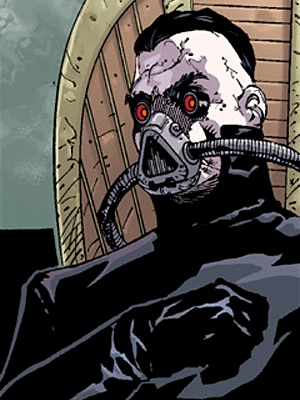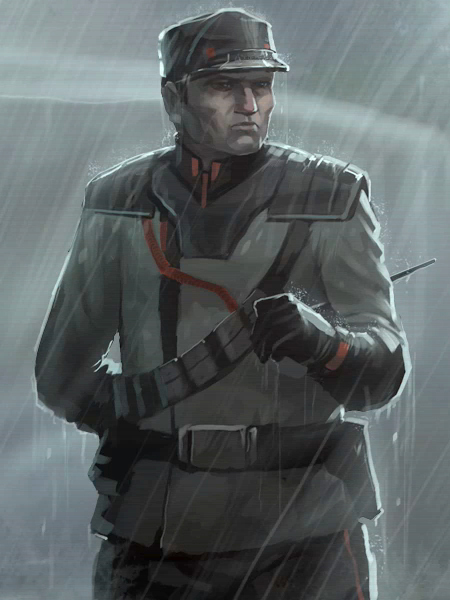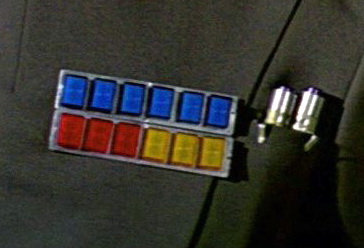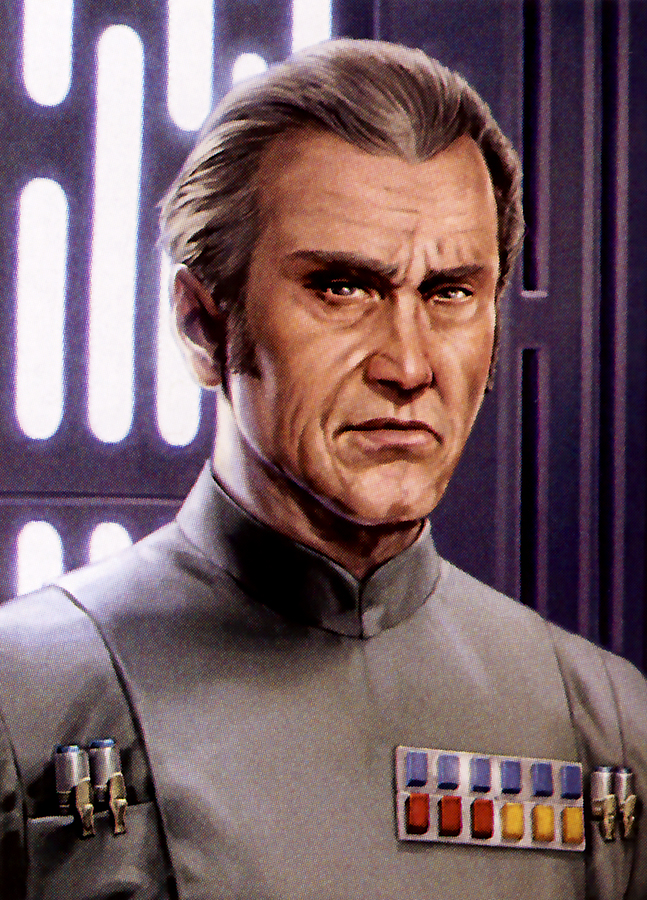Grand Moff was a political and military title in the hierarchy of the Galactic Empire. Grand Moff was first given to the regional governors of oversectors, also called Priority Sectors, were locations that were of special interest, such as Coruscant and the Death Star. The title was carried over by the Council of Moffs, where a holder served as the de jure highest official of the Imperial Remnant, a successor to the Galactic Empire.
The system itself predates the Old Empire, with Odile Vaiken was the first to be made Grand Moff under the Sith Empire, while Wilhuff Tarkin was the first Grand Moff of the Galactic Empire, and held authority over multiple Priority Sectors.

Grand Moff Trachta ruled over the Imperial Center Oversector in 1 BBY.
A Grand Moff received drastically increased authority, military forces, and funding befitting their enhanced position. The position of Oversector governor was the sixth highest in the power structure after the Emperor, Supreme Commander, Grand Vizier, Advisors, and Grand Admirals. They answered only to the sovereign and competed for his favor.. While regular Moffs could be appointed by Advisors, only the Emperor himself could elevate dignitaries to Grand Moffs. The actual nature of the upper levels of the Imperial government was extraordinarily complicated, partially because the Emperor wanted those directly below him to be uncertain where their position truly stood.
Though Grand Moffs were handpicked by Emperor Palpatine himself, the first of their number, Grand Moff Wilhuff Tarkin, was actually promoted by Lord Ars Dangor after the submission of the Tarkin Doctrine.
The Grand Moffs were higher in authority than the Moffs but there is no indication that Moffs actually reported to the Grand Moffs. Instead, the Grand Moffs held direct control over their territories. Grand Moffs also had drastically different levels of power with Grand Moff Tarkin, having control over most of Oversector Outer, while Grand Moff Bertroff Hissa likely only had control over the Kessel sector. It is possible Palpatine weakened the title after the disaster with the Death Star, though this may merely be circumstantial in Hissa's case.
In theory, the Advisors were more prestigious than the Grand Moffs and closer to the Imperial seat of power on Imperial Center. Their direct access to the Emperor gave them less practical power than Grand Moffs, who wielded supreme authority over their territories in a manner that brooked little opposition, granting immutable power over any and all agencies within their borders. This is demonstrated by the Grand Moffs' role in the Imperial Mutiny. Part of this may be because the Advisors had no military power by themselves while the Grand Moffs had their massive Oversector Fleets.
The Grand Moffs of the Legacy era wielded quite different authority than the Mofference under Palpatine. The Grand Moffs of this era did not seem to act as Regional Governors but instead have seemingly replaced the Ruling Council of the Emperor. The heads of Imperial Intelligence, Supreme Commander, and head of the Imperial Mission were all Grand Moffs on the Council.

Zellos, an Old Republic–era Grand Moff.
The title of Grand Moff was neither Palpatine's nor Tarkin's invention, though both can be credited with resurrecting the title for Imperial use. In fact, the title dates back to the Expansionist Period (ca. 25,000–20,000 BBY), when the Republic frequently encountered many small satrapies and mini-empires. The warlords and satraps who joined the Republic instead of fighting it were permitted to keep their rule as proxies of the Republic, and their realms were granted the status of Allied Regions. Depending on the size of their empires, these satraps were given the title of either Moff or Grand Moff of an Allied Region. Over the ensuing millennia, most of the Allied Regions were divided into Republic sectors and gradually faded from the maps. The few Moffs and Grand Moffs that remained held largely ceremonial titles, and ultimately those titles, like so many of the remnants of the ancient Republic, were swept away during the Ruusan Reformation (ca. 1000 BBY). By the time of Palpatine, there were very few Allied Regions remaining, and most of those were small areas of space in the Core and Colonies, such the Ollonir Boundaries or the Botor Enclave.
Thousands of years before its use by the Galactic Empire, the title found in use in the Sith Empire in the years during and following the Great Galactic War, although it seemed that under the Sith it was only an honorary title. One notable example of the Sith's use of the title was Grand Moff Rycus Kilran.
From the time of the Reformation on, the galaxy was organized into 1,024 regional sectors, which were themselves divided into their constituent subsectors. Under Republic law, the Supreme Chancellor could appoint a governor-general to coordinate military actions with the Senator of a troubled sector in a time of emergency. During the Clone Wars (22–19 BBY), Supreme Chancellor Palpatine frequently took advantage of this once-obscure law, appointing officers answerable directly to him as governors-general over both Republic worlds in crisis and Separatist worlds that had recently been liberated. When such actions met with criticism, Palpatine replied that with the passage of the Reflex Amendment (20 BBY), it was not just his right but his duty. In fact, the crisis gave him a good excuse to begin establishing a bureaucracy that was directly beholden to him.

Wilhuff Tarkin's rank insignia
The passage of the Sector Governance Decree (19 BBY) gave then-Supreme Chancellor Palpatine the power to carry this process forward and appoint governors-general over the Republic's 1,024 regional sectors, establishing a new permanent administrative class answerable to him only. With the inauguration of the Empire days later, the honorary title of Moff was announced for these new regional governors. The use of this title was calculated; many peoples of the galaxy still retained a sense of identity that had been derived from the traditions of the ancient Allied Regions, and they cheered the revival of this title in a new capacity as a check to a Senate most derided as corrupt. The first of these Moffs were installed within weeks, accompanied by a full regiment (2,304 soldiers) of stormtroopers.
Under the Sector Governance Decree, twenty of these new Moffs were also given responsibility for supporting the Republic's twenty Sector Armies, and their military territories, generally matching the sphere of influence of their respective Sector Armies, were dubbed oversectors. These oversectors straddled the boundaries of regional sectors and freed these twenty Moffs from the need to consult with the Senators representing these regional sectors. In the course of the Empire's further militarization (ca. 5 BBY), Moff Wilhuff Tarkin submitted a special holocommunique to Emperor Palpatine suggesting a reorganization of these oversectors as part of his Tarkin Doctrine. This was an attempt to cope with the problems of increasing Rebel activity across sector lines. Palpatine evidently approved of this suggestion, and acted accordingly; some of the previous oversectors—such as Imperial Center Oversector—were left in place, but others were expanded—Tarkin's own territory, the Greater Seswenna Sector, was enlarged into Oversector Outer. Others still disappeared entirely, replaced by a shifting number of oversectors comprising systems in which Rebel activity was particularly pronounced. With the permanence of oversectors codified into law, the ancient title of Grand Moff was revived and awarded to those Moffs who controlled these oversectors. Governor Tarkin was the first of these, and with this promotion to priority sector high commander of Oversector Outer came Emperor Palpatine's command to restart work on the Death Star project.
The rank suffered the first in a series of scandals when Grand Moff Trachta joined with others in the Anti-Sith conspiracy, an attempted coup d'état against the reigning Sith Lords. The plot failed and the treacherous Grand Moffs were executed for their betrayal. This would not be the end of their plotting since the Emperor suspected correctly that Governor Tarkin also held ambitions towards the throne.
During the Galactic Civil War, the Rebellion captured Grand Moff Ravik and intended to imprison him for trial when he was killed in a strange adventure involving the Charon. The mutated Grand Moff Ravik was eventually killed by Rebel Alliance agents.

Grand Moff Ardus Kaine, who established himself as dictator of the Pentastar Alignment after the Battle of Endor.
The death of the Emperor resulted in a free for all amongst Imperial warlords for rule of the galaxy. One of the most powerful of breakaway warlords was Grand Moff Ardus Kaine. The successor of Grand Moff Tarkin created the powerful Pentastar Alignment that solidified Imperial power in the Outer Rim territories but removed a substantial portion of Coruscant's influence. Grand Moff Kaine would be killed during Operation Shadow Hand when his shuttle was ambushed by Republic E-Wings..
Another act of Grand Moff treason occurred when Grand Moff Hissa united several powerful Moffs together into the Central Committee of Grand Moffs that attempted to usurp Ysanne Isard's rule over the galaxy. Despite having the forces of three Grand Admirals at their service, their coup failed with most sentenced with prison sentences. The exception to this was Rufaan Tigellinus, whom was executed by the Moffs for demanding a higher position amongst their ranks. The power of the Grand Moffs would be broken for the remainder of the Galactic Civil War.
It is noteworthy that in the events immediately preceding the Imperial Civil War in 10 ABY at least some Moffs (which might include Grand Moffs) rebelled against the thought of a new Emperor being elected by the Advisory alone. These campaigned for their worlds to be given vote representation to allow them to control the process of selecting the next leader of the galaxy. At least one Grand Moff, Cinzero Gann, survived as a Warlord in the Deep Core as late as 18 ABY.
The position would be revived in the Legacy era with the Council of Moffs replaced by the Moff High Council. Presumably, this is the result of Imperial expansion. It is during this time that Grand Moff Morlish Veed and his consort Nyna Calixte collaborated with the Sith in yet another Moff born coup d'état against Emperor Roan Fel. The coup was supposed to place Morlish Veed on the throne but instead ends with his position unchanged in the Empire. Instead, the Dark Lord of the Sith Darth Krayt assumed the Imperial throne.
The Grand Moff's rank insignia was composed of six blue, three red, and three yellow squares. This indicated that the Grand Moff possessed a rank in the military higher than even that of an Admiral or General in the Imperial armed forces. It also bore some similarities to the rank insignia of Priority Sector High Commander established post-Battle of Yavin as a temporary rank until the Imperial military was reorganized. It also possessed four code cylinders, two of which are adopted on the right edge of the uniform. Some versions, however, utilized seven red squares over seven blue, along with four code cylinders.
With the establishment of the second Galactic Empire, the insignia of Grand Moffs changed. The new insignia comprised two epaulets joined by a neck-brace-like adornment worn instead of the usual rank insignia.
- Grand Moff Odile Vaiken
- Grand Moff Zellos
- Grand Moff Rycus Kilran
- Grand Moff Resh
- Grand Moff Ilyan Regus

Morlish Veed, Grand Moff under Emperors Roan Fel and Darth Krayt
- Grand Moff 4-8C (IG-series droid)
- Grand Moff Argon
- Grand Moff Bartam
- Grand Moff Naomi Dargon (Corellian Oversector)
- Grand Moff Dunhausen
- Grand Moff Dureya
- Grand Moff Gann (Sector 5)
- Grand Moff Lynch Hauser (Dustig Oversector)
- Grand Moff Bertroff Hissa (Kessel sector)
- Grand Moff Ardus Kaine (Oversector Outer, replaced Tarkin)
- Grand Moff Kintaro (Sarin Oversector)
- Grand Moff Kohl Seerdon (Sector 3)
- Grand Moff Muzzer
- Grand Moff Nigel Nivers (Tandankin)
- Grand Moff Ravik (Tolonda sector)
- Grand Moff Ambris Selit
- Grand Moff Siralt
- Grand Moff Tanniel
- Grand Moff Wilhuff Tarkin (Oversector Outer)
- Grand Moff Tharil Tavira (Eiattu 6)
- Grand Moff Thistleborn
- Grand Moff Rufaan Tigellinus
- Grand Moff Trachta (Imperial Center Oversector)
- Grand Moff Traeda
- Grand Moff Nox Vellam
- Grand Moff Fliry Vorru (Corellian Oversector)
- Grand Moff Gerald Weizel
- Grand Moff Wilkadon (Askaj)
- Grand Moff Zsinj (Quelii Oversector)
- Grand Moff Quille
- Grand Moff Siralt
- Grand Moff Morlish Veed (also Grand Admiral and High Moff)
The title of Grand Moff came from the title, "Grande Mouff", that was originally given to a (much changed) Tarkin from the rough, first, second and third draft drafts of Star Wars. In the former two drafts, Tarkin was a religious leader on Aquilae or Townowi; in the second and third drafts he was the Rebel commander of the Kesselian Dragoons on Yavin 4.
At least in earlier drafts of Return of the Jedi, a Grand Moff is superior to the Supreme Commander: Commander Tiaan Jerjerrod had been a Grand Moff and Lord Vader saluted him.
Due to events of Revenge of the Sith, Grand Moff Tarkin's promotion must have taken place during or perhaps even before the events of the film. This is due to the fact that Governor Tarkin was elevated to the position directly as a result of the Tarkin Doctrine and was only assigned the Death Star project because of it. Given that the Death Star is partially completed during the film, and that Regional Governors are a product of the Clone Wars, it is entirely possible that this was an Old Republic decision rather than an Imperial one.
This is a complex problem given that the Death Star Technical Companion was written with the idea of Governor Tarkin being elevated to Grand Moff during the Empire's reign and the Death Star being constructed well into the Imperial era.
- "A Death Star Is Born" — Star Wars Tales 12
- "The Princess Leia Diaries" — Star Wars Tales 11
- LEGO Star Wars II: The Original Trilogy
- LEGO Star Wars: The Complete Saga
- † Star Wars Infinities: A New Hope
- † Tag & Bink Are Dead
- Choose Your Own Star Wars Adventure: A New Hope
- The Epic Continues